2024 Chevrolet Blazer EV RS: Two Good Choices
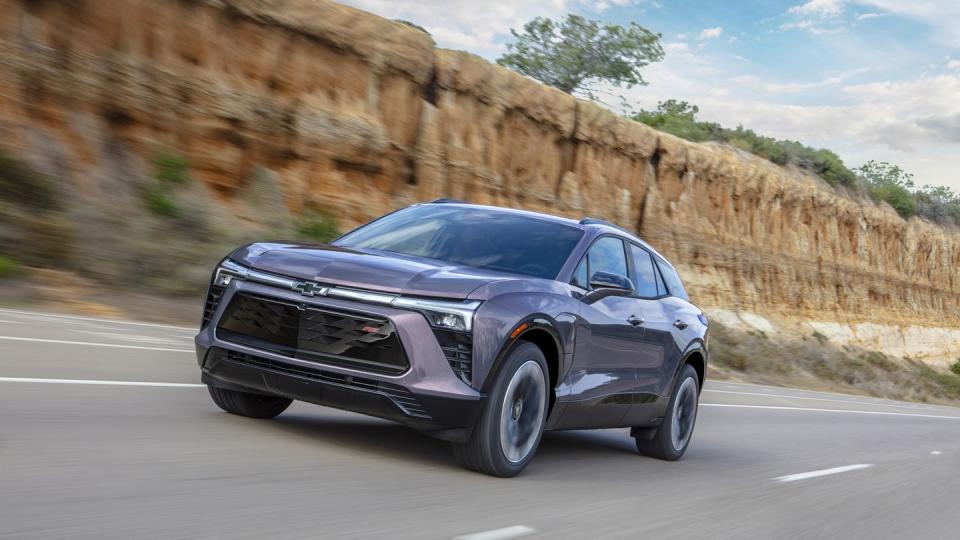
There's usually not enough choice in the automotive world, but the 2024 Chevrolet Blazer EV offers variety that goes well beyond the norm. Its Ultium electric vehicle platform supports no less than four drive schemes: front-wheel drive, rear-wheel drive, and two distinct varieties of all-wheel drive. A high-performance SS model will be made available to enthusiasts, and similar bits will be repackaged for the "enthusiasm interventionists" in your local constabulary.
Meanwhile, the gasoline-powered "ICE Blazer," as certain GM insiders refer to it, is on a different platform and a different path. It will evolve on a separate trajectory with a more trucklike persona, while the Blazer EV takes a sleeker and sportier tack.
There's barely a quarter-inch difference in the overall lengths of the two, but all similarities end there. The Blazer EV's 121.8-inch wheelbase dwarfs the regular Blazer's 112.7-inch span, and the Blazer EV is also 1.3 inches wider but has a roofline that crouches two inches lower. Draped in fluid sheetmetal that makes the Cadillac Lyriq look like a rookie pinewood derby entry, the gorgeous Blazer EV absolutely has the longer, lower, wider vibe down pat.
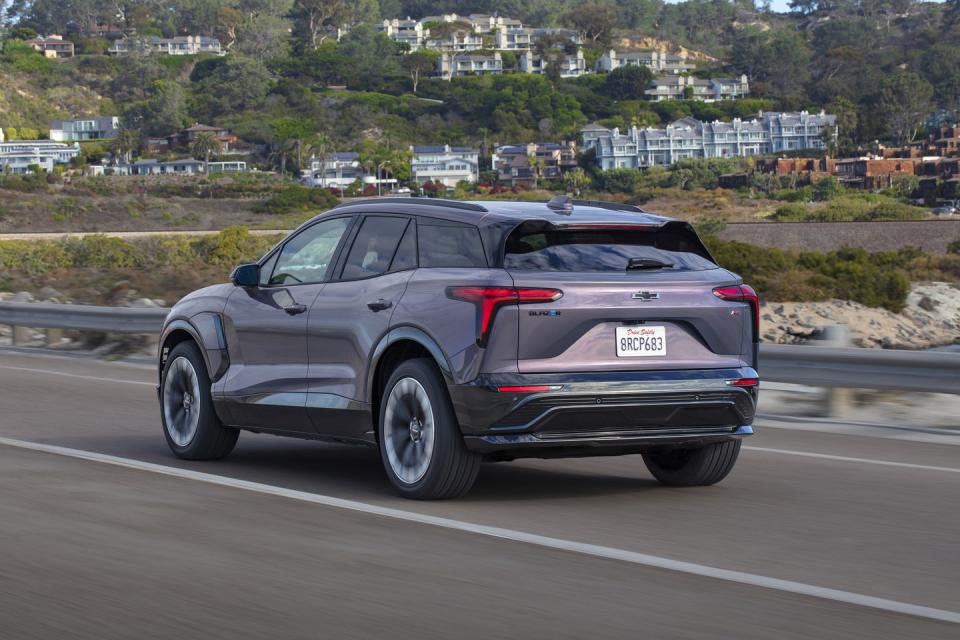
RS Means Rally Sport? Rather Sensible? Both?
Two of the four powertrains have broken cover so far, and both power RS models in the middle of the lineup. We were able to drive both, and their characters largely track with their power outputs. The all-wheel-drive RS utilizes what GM calls its eAWD system, with dual motors that team up for 288 horsepower and 333 pound-feet of torque. That's substantially less than the 500 horsepower generated by the all-wheel-drive Cadillac Lyriq 600E4 and the 557 horses claimed for the upcoming Blazer SS in its face-palmy WOW (Wide Open Watts) mode.
Why is the eAWD powertrain comparatively weak? It's a part-time all-wheel-drive system that utilizes a 241-hp, 225-lb-ft permanent-magnet synchronous motor to power the front wheels. The rear axle is intermittently powered by a much smaller 90-hp induction motor that trails along idly most of the time, waiting for its chance to assist when the front tires slip or the driver drops the hammer—bursts that usually last little more than a dozen seconds. This is not a performance-oriented AWD setup, but a Rather Sensible one geared to slippery conditions.
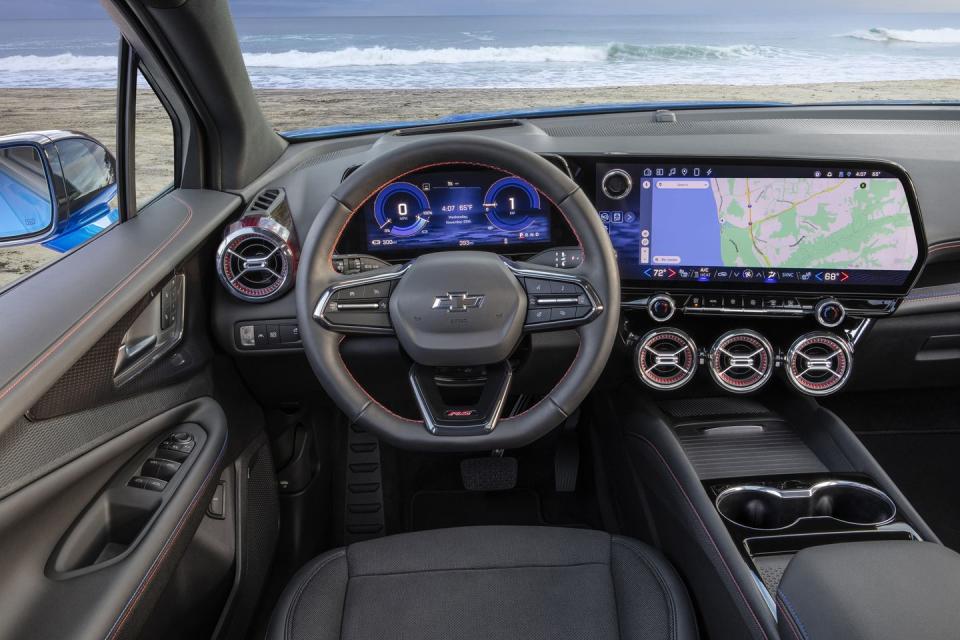
Meanwhile, the rear-wheel-drive Blazer EV RS feels considerably more sprightly, its lone 340-hp and 325-lb-ft motor powering the rear wheels. It's very much like the Cadillac Lyriq 450e Debut Edition but better looking. The rear-drive RS feels considerably more eager than the RS eAWD, and it punches out of corners with the kind of squat you only get from a rear-drive layout. The rear-drive RS does indeed give off a whiff of Rally Sport demeanor. As for GM's thinking, it expects the rear-drive RS to sell well in places where it is Relatively Sunny.
Battery Packaging
Two 400-volt lithium-ion batteries are on offer. The smaller one features 10 modules that give it 85.0 kilowatt-hours of usable capacity and a 150-kW maximum DC fast-charge speed. The larger one utilizes 12 modules that imbue it with 102.0 kilowatt-hours of usable juice and 190 kilowatts of best-case DC fast-charge capability.
Curiously, the larger battery powers the rear-drive RS, while the RS eAWD gets the smaller fitment. Why? This makes the eAWD the cheaper choice, even though its EPA-estimated 279 miles of range might seem iffy in frostier frontiers. The less complicated RWD model costs more, but only $1575 more—and provides an estimated 324 miles of range. Chevrolet has managed to make the AWD one cheaper while keeping the price of the longer-range one in check. It's a neat bit of sleight of hand.
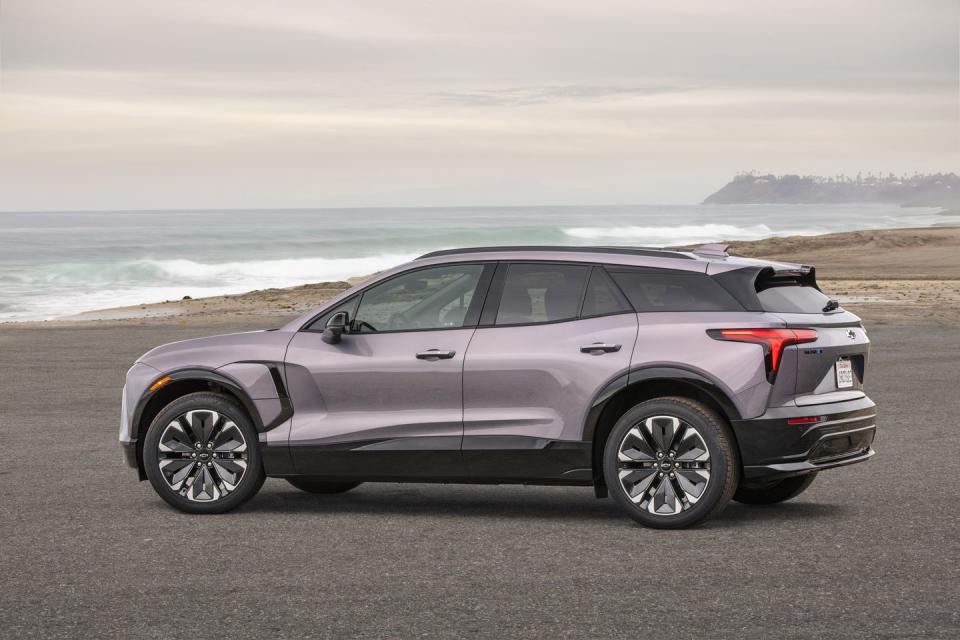
Ride and Response
The RS twins are impressive on the road. Both cover ground with smooth fluidity that belies their standard RS-issue 21-inch rolling stock. Body motions are supple but never buoyant, and road impacts and coarse textures don't upset the applecart. There's even less road noise than we expected, possibly because the 275/45R-21 Bridgestone Alenza A/S 02 self-sealing tires utilize a silicon layer to seal leaks as they occur, not stiff run-flat sidewalls that support a vehicle after air loss.
The brakes do the business, but you'll only notice if you turn the regenerative system off—easily done with a toggle on the touchscreen. The brake feel is consistent and natural with regen off, thanks to decent blending of the electronic brake booster. If you like regenerative braking, you can set the toggle two ways: High/off or Normal/off. Normal is a comfortable regen level for when you have passengers, whereas High makes one-pedal driving more suitable for aggressive alone time.
The thing about cornering, though, is the steering doesn't quite hold up its end of the bargain. Response is satisfyingly predictable, and the body doesn't lean overmuch, but there's no real feel beyond a slathering of effort that masks how the tires are bearing up. The difference between the Normal and Sport setting is just two levels of uninformative background effort. Thing is, either setting is agreeable when cruising straight highways, because the system does exhibit decent straight-ahead sense.
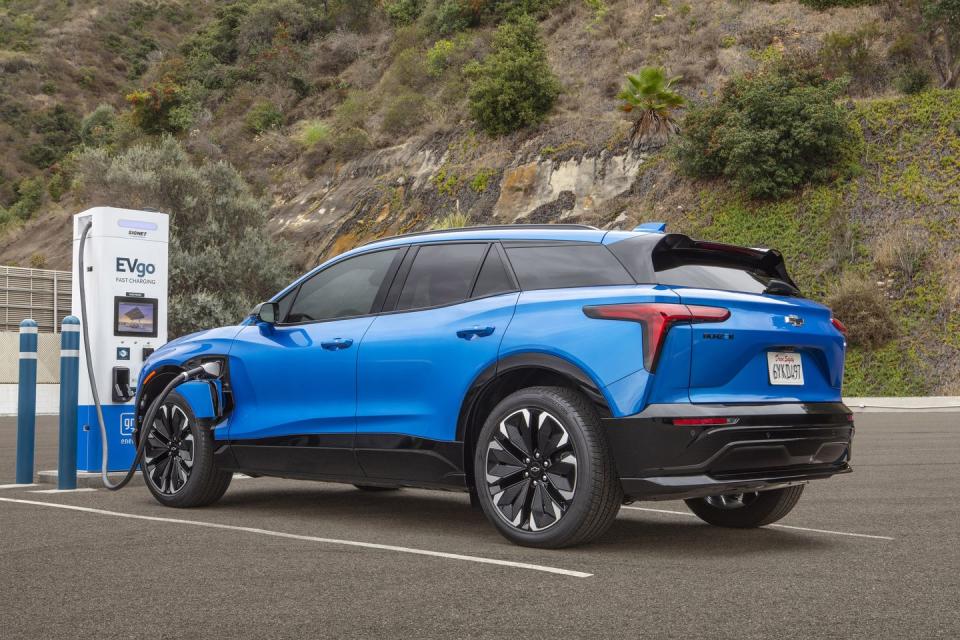
Sizable Interior, Controversial Infotainment
Inside, the Blazer EV's more-stylish-than-the-Lyriq feeling continues. It's tasteful and logical, and even the red-themed interior of our sample car came across as handsome, not hokey. The seats are comfy, and the driving position is highly adaptable. The steering-wheel rim is chunky, its spoke-mounted controls straightforward.
There's abundant room, too, such that our six-foot-two-inch tester can sit behind himself with toe room in excess and knee room to spare. Lowering the rear seatbacks to expand cargo space from 26 to 60 cubic feet, there was no need to move the driver's seat forward because the flopping rear headrests cleared by a mile. Space-wise, this would make a roomy road-tripper or a laudable Lyft.
The two display screens are positively huge and easy to interact with. The one to your right, which measures 17.7 inches, is so sizable that the presence of permanent virtual buttons rimming its periphery hardly puts a dent in the acreage. It's a Google Built-In system, and the subscription is fully paid for eight years. But there's no Apple CarPlay or Android Auto. Not wireless, not wired. Not at all. At first we were outraged, then we took a few sips of the Kool-Aid.
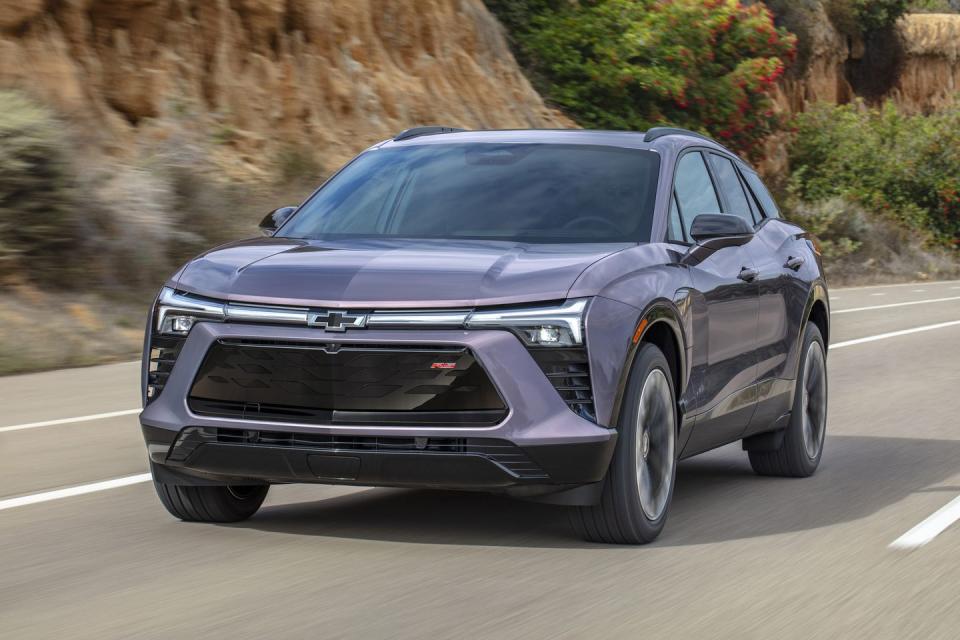
I use Goggle Maps with my iPhone anyway, but it's always here. Waze, too. ("Is this grape?") I use Spotify for music, and that's embedded here too—along with others. Log in by aiming your camera at a QR code on the screen. Boom. No cords, and the phone battery could go dead at this point, and it wouldn't matter. ("Wait, no, it's raspberry.") Next, Google Voice search is better than Siri. But the best part is how EV charging information is embedded into Google Maps. Charging points are indicated and suggested, and the remaining battery charge at each waypoint is displayed alongside the remaining miles and ETA. With a flip of a steering-wheel button, the whole thing is ported to the instrument cluster, big as life.
If I really want MY music on MY phone, the Bluetooth pairing I need for phone calls and texts brings that in too. And it's all done much cleaner than in a Rivian or Tesla. Why not have Google Built-In and smartphone mirroring, as in the Colorado? The Colorado is not an EV, so integrating charging into the navigation environment isn't a benefit. Its screens are also much smaller. ("Can I have another glass?")
Having said all this, you won't be convinced until you try it. Some people will want the familiarity of Apple CarPlay and Android Auto anyway. We get it. But this setup absolutely offers advantages in an EV context.
Surprisingly Pricey
The RS eAWD starts at $60,215, while the longer-range rear-drive RS goes for $61,790. You might see lower figures elsewhere, but two erstwhile options are "Required to Order" musts. All RS models are being built with the $2620 RS Convenience and Driver Confidence Package that includes a head-up display, heated outboard rear seats, 360-degree camera system, adaptive cruise (easily set to normal cruise!), rear pedestrian alert, reverse automatic braking, side bicyclist alert, enhanced automatic emergency braking, intersection automatic emergency braking, a rear camera washer, and a heated wiper park zone. The RS RWD needs another $575 for Bose eight-speaker premium audio.
The Blazer EV RS's just-over-$60K pricing seems dear and surprisingly close to early and more powerful versions of the Cadillac Lyriq. But the eAWD can be had in LT form for $56,715, and the front-drive LT is sure to be the cheapest variant once it surfaces. But of the many Blazers, the EV RS models are spacious vehicles with much to recommend them.
You Might Also Like

 Yahoo Autos
Yahoo Autos 